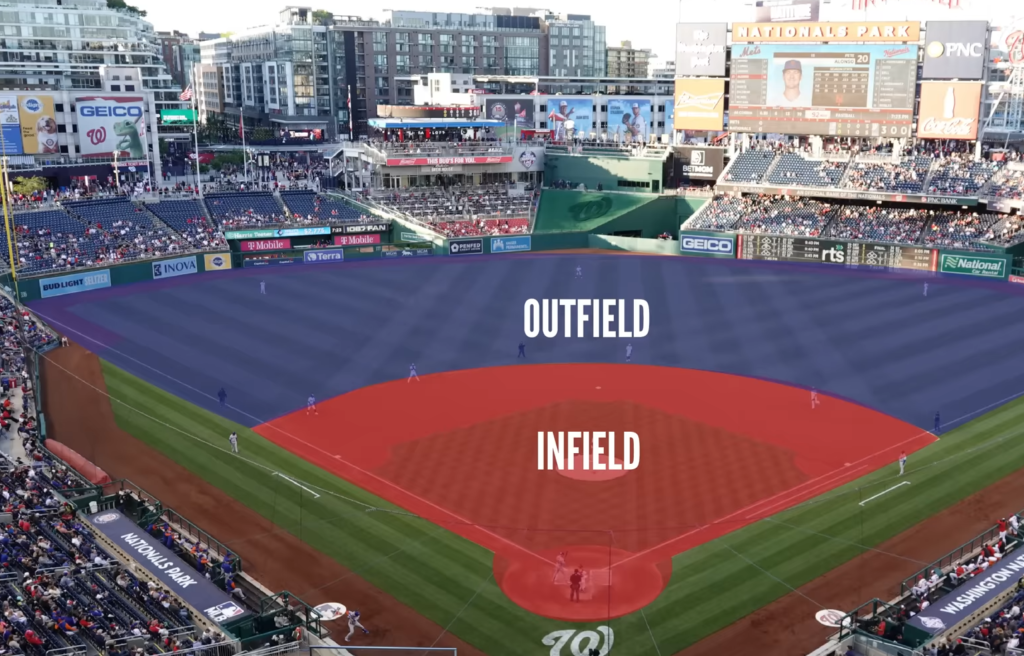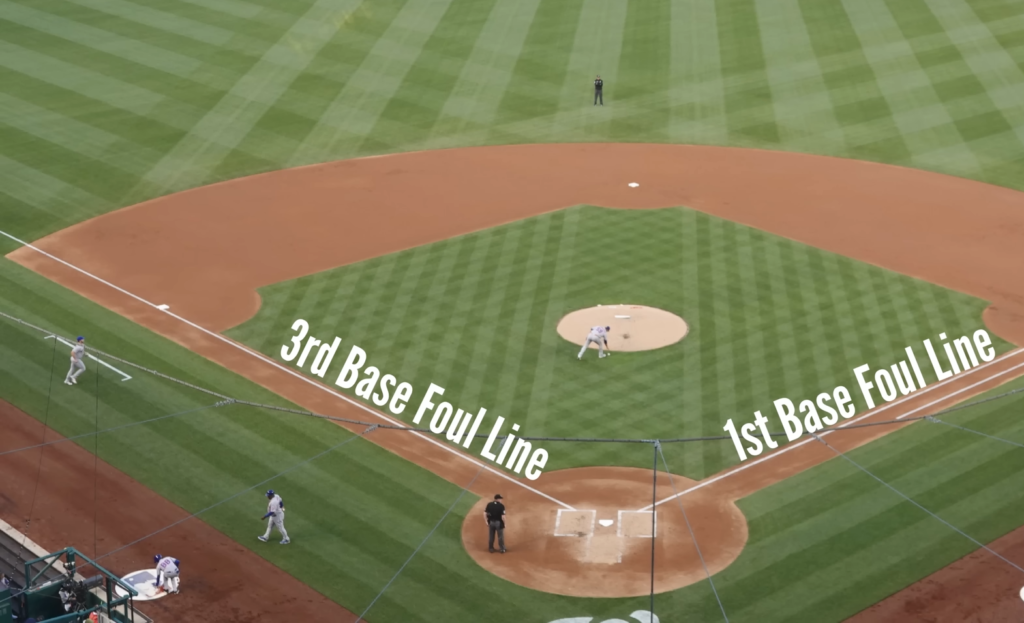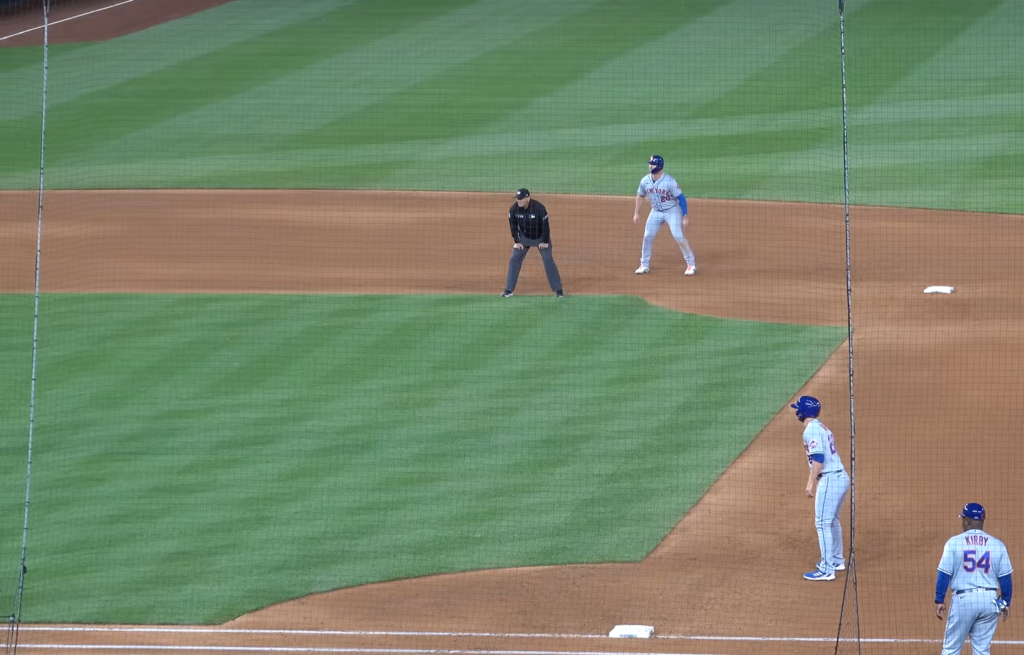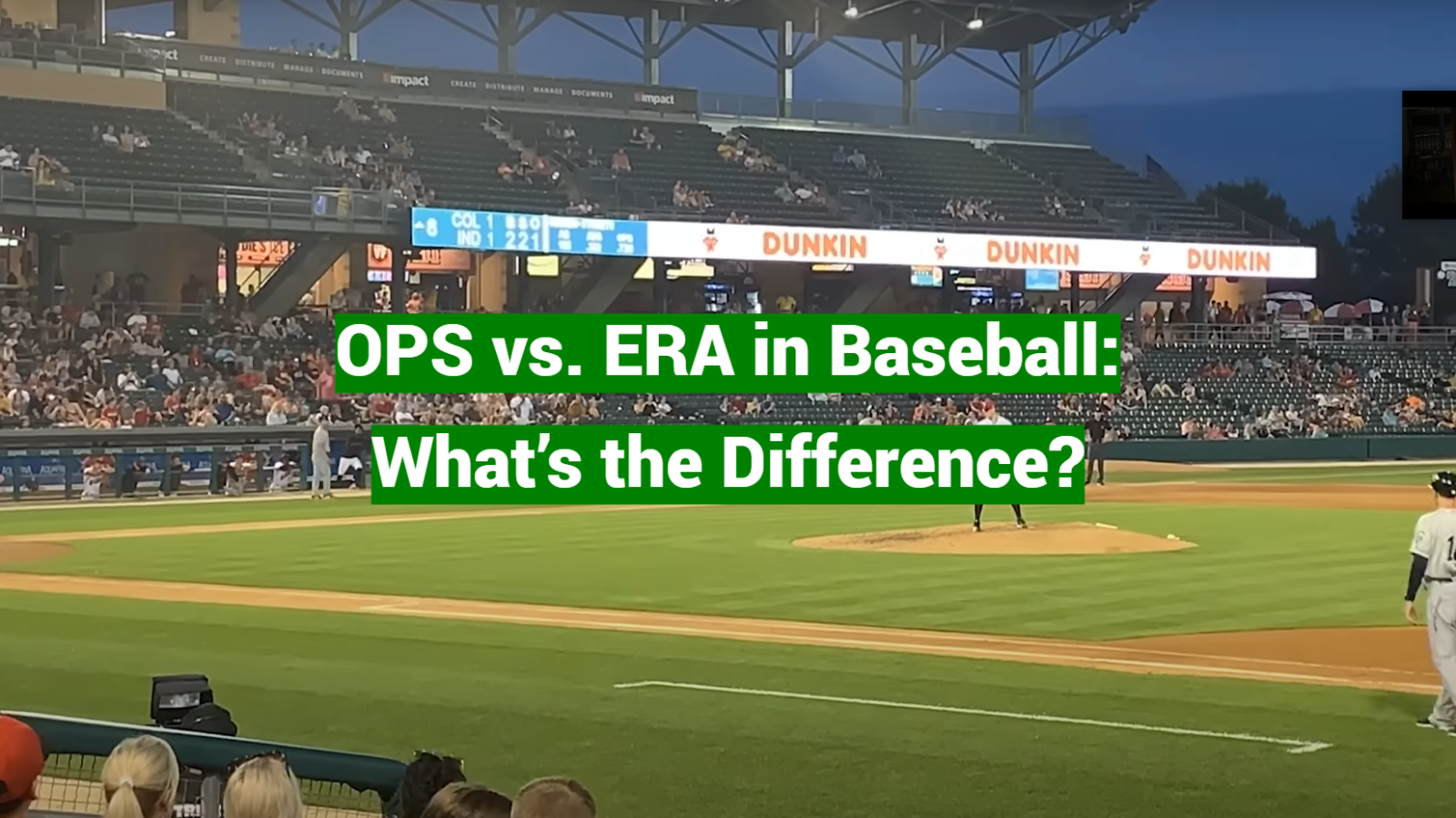In the dynamic realm of baseball statistics, the debate between OPS (On-Base Plus Slugging) and ERA (Earned Run Average) encapsulates the essence of the sport’s intricacies. OPS, a comprehensive offensive metric, amalgamates a player’s on-base prowess and slugging power. Conversely, ERA, a cornerstone for evaluating pitching effectiveness, scrutinizes a pitcher’s ability to thwart earned runs.
This article delves into the distinctions between OPS and ERA, unraveling their unique roles in deciphering the multifaceted performances of hitters and pitchers. As we navigate this statistical terrain, we explore their applications, merits, pitfalls, and the perennial question: which metric holds greater sway in the game of baseball?
Table of Contents
Baseball Statistics Explained

Here are some key baseball statistics explained:
Batting Average (BA):
- Formula: BA = Hits / At Bats;
- Description: Measures a player’s ability to get hits. A higher batting average indicates a better ability to make contact with the ball;
On-Base Percentage (OBP):
- Formula: OBP = (Hits + Walks + Hit by Pitch) / (At Bats + Walks + Hit by Pitch + Sacrifice Flies);
- Description: Measures a player’s overall ability to reach base. It considers hits, walks, and hit by pitch;
Slugging Percentage (SLG):
- Formula: SLG = (Total Bases / At Bats);
- Description: Measures a player’s power and extra-base hitting ability. It gives more weight to extra-base hits;
On-Base Plus Slugging (OPS):
- Formula: OPS = OBP + SLG;
- Description: Combines on-base percentage and slugging percentage to provide a more comprehensive measure of a player’s offensive contribution;
Earned Run Average (ERA):
- Formula: ERA = (Earned Runs / Innings Pitched) * 9;
- Description: Measures a pitcher’s effectiveness in preventing runs. A lower ERA indicates better pitching performance [2];
WHIP (Walks Plus Hits Per Inning Pitched):
- Formula: WHIP = (Walks + Hits) / Innings Pitched;
- Description: Measures a pitcher’s ability to prevent baserunners by considering walks and hits allowed per inning pitched;
Fielding Percentage:
- Formula: Fielding Percentage = (Total Chances – Errors) / Total Chances;
- Description: Measures a player’s fielding proficiency. It is the ratio of successful fielding attempts to total opportunities;
Wins Above Replacement (WAR):
- Description: A comprehensive statistic that attempts to measure a player’s total value, taking into account both offensive and defensive contributions. It represents the number of wins a player adds to their team compared to a replacement-level player;

Stolen Base Percentage:
- Formula: Stolen Base Percentage = (Stolen Bases / (Stolen Bases + Caught Stealing));
- Description: Measures a player’s efficiency in stealing bases. A higher percentage indicates better base-stealing ability;
Runs Batted In (RBI):
- Description: Measures a player’s effectiveness in bringing baserunners home. It credits a batter with driving in runs when a teammate scores due to their hit, walk, or hit by pitch;
Understanding these statistics can provide a more in-depth analysis of a player’s performance and contribute to evaluating team dynamics. Different metrics are used for batters, pitchers, and fielders to assess various aspects of the game.
What Is OPS In Baseball:
OPS, or On-Base Plus Slugging, is a baseball statistic that combines a player’s on-base percentage (OBP) and slugging percentage (SLG). It provides a more comprehensive measure of a player’s offensive contribution by taking into account both their ability to get on base and their power hitting [3].
OPS Records:
OPS records are used to track and compare the offensive performance of baseball players. High OPS values are generally associated with strong offensive players who excel at both getting on base and hitting for power. Players with historically high OPS values include legends like Babe Ruth, Barry Bonds, and Ted Williams.
Benefits of Using the OPS Statistic:
- Comprehensive Offensive Measure: OPS considers a player’s ability to get on base (OBP) and their power hitting (SLG), providing a more complete picture of offensive performance;
- Easy to Understand: OPS is a simple sum of two well-known statistics (OBP and SLG), making it easy for fans, analysts, and teams to grasp and use for player comparisons;
- Versatility: OPS is applicable to both individual players and teams, making it a versatile statistic for evaluating offensive prowess;
Drawbacks of Using the OPS Statistic:
Weighting Issues: OPS treats OBP and SLG as equal contributors, but some argue that on-base skills might be more valuable than slugging. This can oversimplify the offensive evaluation process.
Park and Era Effects: OPS values can be influenced by the park a player plays in and the era in which they compete. Comparing OPS across different time periods or ballparks may not be entirely fair.
How Is OPS Calculated?
The formula for OPS is straightforward [4]:
OPS=OBP+SLG
Where:
- OBP (On-Base Percentage) is calculated as (Hits+Walks+HitbyPitch)/(AtBats+Walks+HitbyPitch+SacrificeFlies);
- SLG (Slugging Percentage) is calculated as (TotalBases/AtBats);
What Is a Good OPS In Baseball?
OPS values can vary, but in general, an OPS above .800 is considered above average, while an OPS above .900 is considered excellent. Elite hitters may have OPS values well over 1.000 [5].
OPS and Pitchers:
While OPS is primarily used to evaluate hitters, it can also be used in a limited way to assess a pitcher’s performance. However, traditional pitching statistics like ERA and WHIP are more commonly used for pitcher evaluation. For pitchers, a lower OPS against would indicate better performance.

OPS and Major League Baseball:
1) Rise of OPS in MLB
Prior to the 1970s, batting average reigned supreme as the gold standard for evaluating hitters. However, as sabermetrics, the study of baseball through statistics, gained prominence, the limitations of batting average became apparent. It solely focused on hits, neglecting vital aspects like walks and extra-base hits. Enter OPS, devised by Bill James, the godfather of sabermetrics, in 1977.
2) OPS and Player Evaluation
While batting average still holds its place, OPS has revolutionized player evaluation. Scouts, analysts, and fans alike now utilize OPS to identify impactful hitters. A high OPS generally indicates a well-rounded offensive player, excelling in both getting on base and hitting for power. Players with an OPS above .800 are considered above average, while those exceeding 1.000 are elite producers. However, OPS isn’t the sole decision-maker. Factors like situational hitting, plate discipline, and base-running also play crucial roles.
3) OPS and the Evolution of the Game
The rise of OPS coincides with a shift in the offensive landscape of MLB. The “launch angle revolution” has emphasized hitting for power, leading to an increase in home runs and strikeouts. This trend is reflected in OPS numbers, with the league average hovering around .750 in recent years compared to .680 in the 1970s [7]. Interestingly, OPS doesn’t necessarily favor this power-focused approach. While slugging contributes significantly, a high on-base percentage remains valuable for generating runs. This creates a fascinating dynamic where players must find a balance between power hitting and getting on base consistently.
4) OPS Career Leaders
The all-time OPS leader in MLB history is the legendary Babe Ruth, boasting an incredible 1.1636 OPS. Other legends like Ted Williams, Barry Bonds, and Mike Trout hold prominent positions on the career leaders list. Notably, several active players like Mike Trout, Juan Soto, and Shohei Ohtani are on track to challenge these historical figures, showcasing the ever-evolving offensive landscape of the game.
What Is OPS+ In Baseball?
While OPS offers a valuable insight, it doesn’t account for external factors like ballpark dimensions and league-wide offensive trends. To address this, OPS+ was developed. Essentially, OPS+ adjusts a player’s OPS relative to the league average and park factors, setting a baseline of 100 [8]. A score above 100 indicates a hitter performing better than the league average offensively, while a score below 100 suggests the opposite. This adjustment provides a more accurate comparison of hitters across different eras and ballparks.

Top 10 MLB players ranked by OPS in 2023
The 2023 season witnessed several players showcasing exceptional offensive prowess according to OPS. Here’s the top 10:
- Mike Trout (Los Angeles Angels): 1.000;
- Juan Soto (San Diego Padres): .921;
- Shohei Ohtani (Los Angeles Angels): .905;
- Aaron Judge (New York Yankees): .894;
- Bryce Harper (Philadelphia Phillies): .881;
- Vladimir Guerrero Jr. (Toronto Blue Jays): .879;
- Fernando Tatis Jr. (San Diego Padres): .876;
- Mookie Betts (Los Angeles Dodgers): .866;
- Paul Goldschmidt (St. Louis Cardinals): .865;
- Jose Ramirez (Cleveland Guardians): .862 [9];
These players not only boast impressive overall OPS, but their individual strengths highlight the diverse offensive strategies that lead to success. Players like Trout and Soto excel in both on-base percentage and slugging, while Judge focuses on pure power hitting. This diversity showcases the versatility that OPS measures and its value in understanding different offensive approaches.
What Is the ERA Statistic:
ERA, or Earned Run Average, is a baseball statistic that measures the average number of earned runs a pitcher allows per nine innings pitched. It is a key metric for evaluating a pitcher’s effectiveness in preventing opponents from scoring.
ERA Records:
ERA records are historical benchmarks that highlight outstanding pitching performances. Some notable achievements include Bob Gibson’s 1.12 ERA in 1968 and Pedro Martinez’s 1.74 ERA in 2000, among others [10].
Benefits of Using the ERA Statistic:
- Pitcher Effectiveness: ERA provides a quick assessment of a pitcher’s ability to prevent runs and is widely used to compare pitchers;
- Easy to Understand: The concept of earned runs allowed per nine innings is simple, making ERA accessible to fans and analysts alike;
- Historical Comparisons: ERA allows for historical comparisons of pitchers across different eras, providing context to their performance;
Drawbacks of Using the ERA Statistic:
- Defense and Park Factors: ERA does not account for defensive quality or the characteristics of the ballpark, which can significantly impact a pitcher’s performance;
- Unearned Runs: ERA only considers earned runs, ignoring runs that score due to defensive errors. As a result, it may not fully reflect a pitcher’s overall effectiveness;
How to Calculate the ERA?

The formula for calculating ERA is as follows:
ERA = (Innings Pitched/Earned Runs) × 9
What Does ERA Not Measure?
ERA does not measure a pitcher’s:
- Strikeout Ability: A pitcher could have a high ERA despite a high strikeout rate;
- Walks and Hits: It does not differentiate between pitchers who allow many baserunners but escape with minimal damage and those who allow fewer but more damaging hits;
- Pitching Efficiency: It doesn’t consider the number of pitches a pitcher throws to complete an inning;
What Is a Good ERA?
A good ERA can vary depending on the era and the league, but generally, an ERA below 3.00 is considered excellent, and an ERA above 4.00 may be considered below average.
Is ERA a Good Indicator?
ERA is a valuable indicator of a pitcher’s ability to prevent earned runs, but it should be used in conjunction with other statistics to provide a more comprehensive evaluation.
Does ERA Correlate To Wins?
While a low ERA is generally associated with winning, a pitcher’s win-loss record is also influenced by run support, bullpen performance, and team defense. Thus, a pitcher with a low ERA may not have a strong win-loss record if other factors are not favorable.
Best ERA Pitchers of All Time:
Some of the pitchers with historically low ERAs include Bob Gibson, Christy Mathewson, Walter Johnson, and modern-era pitchers like Pedro Martinez and Clayton Kershaw.
What Is ERA+ In Baseball?
ERA+ adjusts a pitcher’s ERA based on the league average and the ballpark they play in. An ERA+ of 100 is league average, with values above 100 indicating an above-average pitcher and values below 100 indicating below-average performance [11]. It helps in comparing pitchers across different eras and leagues by normalizing for external factors.
OPS vs ERA: What’s The Difference?
OPS (On-Base Plus Slugging) and ERA (Earned Run Average) are two distinct statistics used in baseball to measure different aspects of the game.
Purpose:
- OPS: Primarily used to evaluate a player’s offensive performance, combining on-base skills and power hitting
- ERA: Measures a pitcher’s effectiveness in preventing earned runs, focusing on their ability to limit opponent scoring;
Components:
- OPS: Combines a player’s On-Base Percentage (OBP) and Slugging Percentage (SLG);
- ERA: Focuses on the average number of earned runs a pitcher allows per nine innings pitched;
Application:
- OPS: Mainly used for batters to assess offensive contribution;
- ERA: Primarily used for pitchers to gauge their effectiveness on the mound;

OPS vs. ERA vs. Other Metrics
OPS and ERA are just two among many baseball statistics. Other important metrics include:
- Batting Average (BA): Measures a batter’s ability to get hits;
- WHIP (Walks plus Hits per Inning Pitched): Evaluates a pitcher’s ability to prevent baserunners;
- WAR (Wins Above Replacement): Assesses a player’s overall value to their team;
- FIP (Fielding Independent Pitching): Focuses on a pitcher’s performance independent of team defense [12];
The choice of metric depends on the specific aspect of the game being evaluated.
Are There Better Stats Than OPS?
Should You Use OPS or ERA Stats?
Choosing between OPS and ERA depends on the context of your analysis:
- Use OPS when evaluating a player’s offensive prowess, such as a batter’s ability to get on base and hit for power;
- Use ERA when assessing a pitcher’s effectiveness in preventing earned runs and overall performance on the mound;
Consider using a combination of statistics to gain a more comprehensive understanding of a player’s or team’s performance. For example, evaluating both a batter’s OPS and a pitcher’s ERA can provide a more well-rounded assessment of a team’s overall success.
FAQ:
1. What are good OPS and OPS+ numbers?
A good OPS for an MLB player is typically above .800, while elite hitters may have OPS values well over 1.000. OPS+ is a normalized version, and 100 is considered league average. An OPS+ above 100 indicates an above-average hitter.
2. What are the common problems with OPS and OPS+?
OPS does not account for defensive contributions, and park effects can impact both OPS and OPS+. Additionally, OPS+ may not fully address external factors influencing offensive performance.
3. What is a good OPS for an MLB player?
Generally, an OPS above .800 is considered above average, and an OPS above .900 is considered excellent.
4. Who has the highest OPS in baseball?
For up-to-date information, check current MLB statistics, as OPS leaders can change throughout a season.
5. Is a 700 OPS good?
A 700 OPS is below average; however, the context of a player’s position and other skills should be considered.
6. Do walks count for OPS?
Yes, walks contribute to a player’s on-base percentage (OBP), which is a component of OPS.
7. Is OPS the same as the batting average?
No, OPS combines on-base percentage (OBP) and slugging percentage (SLG), offering a more comprehensive view of a player’s offensive abilities.
8. Are there better stats than OPS?
Different stats serve different purposes. While OPS is valuable for offensive assessment, other metrics like wRC+ and WAR offer additional perspectives.
9. Is .800 OPS good?
Yes, a .800 OPS is generally considered above average and indicative of a solid offensive performance.
10. Is 2.5 ERA good?
A 2.5 ERA is excellent for a pitcher. Lower ERAs are associated with better pitching performance.
11. Who had the highest OPS in baseball history?
Check historical records for the player with the highest OPS. This can vary depending on the era.
12. Is OPS more important than batting average?
It depends on the context. OPS provides a broader offensive picture, but batting average is still relevant for assessing a player’s ability to make contact.
13. Is a 750 OPS good in baseball?
A 750 OPS is above average, indicating solid offensive production.
14. What is a good OPS for a hitter?
Generally, a good OPS for a hitter is above .800, but this can vary based on position and other factors.
15. What is the most important stat in baseball?
There isn’t a single “most important” stat. Different metrics provide insights into various aspects of the game. For hitters, OPS and wRC+ are often considered important, while ERA is crucial for pitchers.
16. What is the difference between slugging and OPS?
Slugging percentage (SLG) measures a player’s power hitting, while OPS combines SLG with on-base percentage (OBP) to provide a more comprehensive offensive metric.
17. What does an OPS of 1 mean?
An OPS of 1 means the player’s on-base and slugging percentages are equal, indicating an exceptional offensive player.
Useful Video: Understanding Baseball Stats: AVG, OBP, OPS, wRC+, SLG
References:
- https://afhbaseball.com/baseball-statistics-explained/
- https://baseball360.com/blogs/news/what-is-ops-in-baseball
- https://www.usatoday.com/story/sports/mlb/2022/10/02/what-is-ops-mlb-baseball/8061083001/
- https://www.cbssports.com/mlb/news/mlb-advanced-stats-glossary-a-guide-to-baseball-stats-that-go-beyond-rbi-batting-average-era/
- https://fansided.com/posts/commanders-hire-up-and-coming-star-away-from-49ers-to-lead-football-ops-01hkzbjqvk31
- https://www.usatoday.com/story/sports/mlb/2019/07/17/mlb-stats-what-war/1635446001/
- https://thedatajocks.com/what-is-ops-in-baseball/
- https://bleacherreport.com/articles/40132-on-base-percentage-vs-batting-average-which-is-more-important
- https://coachingkidz.com/what-is-ops-in-baseball-well-it-measures/
- https://www.sportingnews.com/us/mlb/news/ops-baseball-meaning-stat-slugging-base-percentage/889639770cdb3b2ac7316521
- https://www.baseballbible.net/what-is-ops/
- https://statcorner.com/mlb/stats/ops-and-ops-plus
- https://www.nj.com/yankees/2009/01/explaining_ops_and_era.html



Leave a Reply